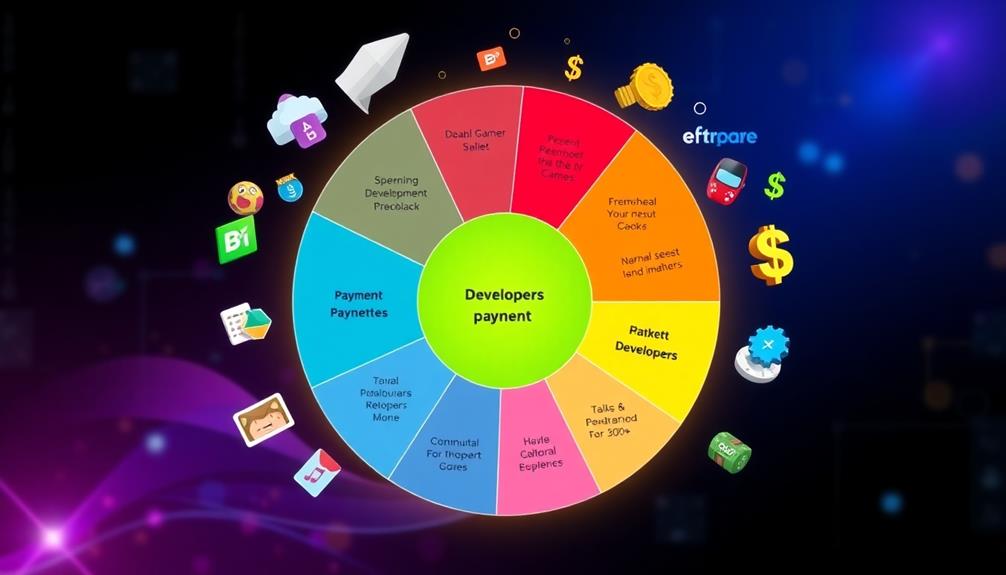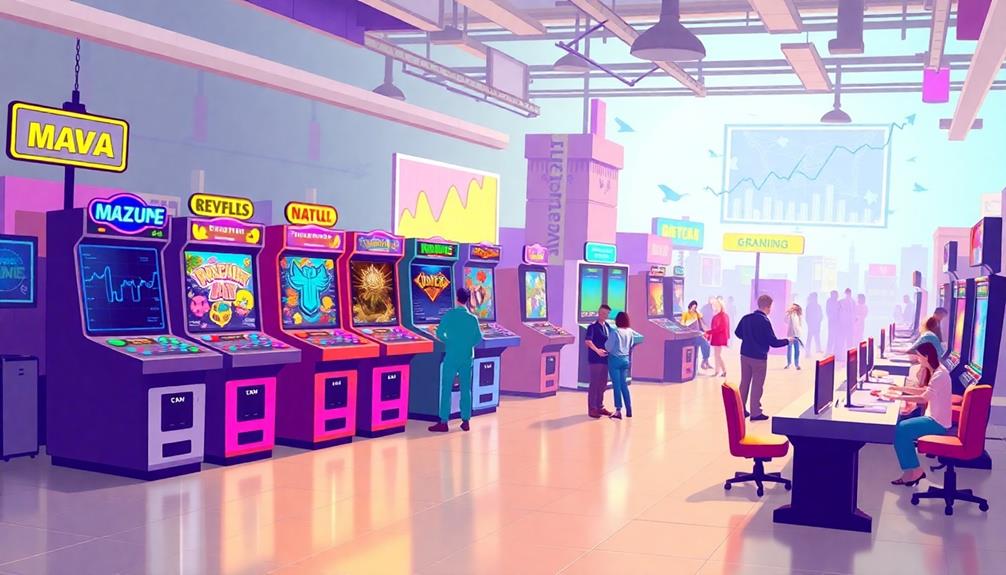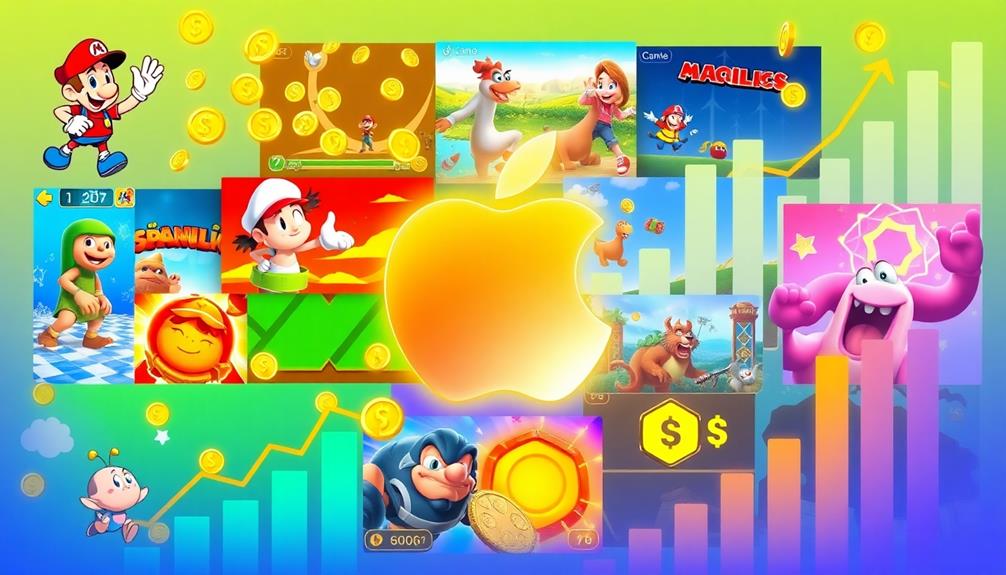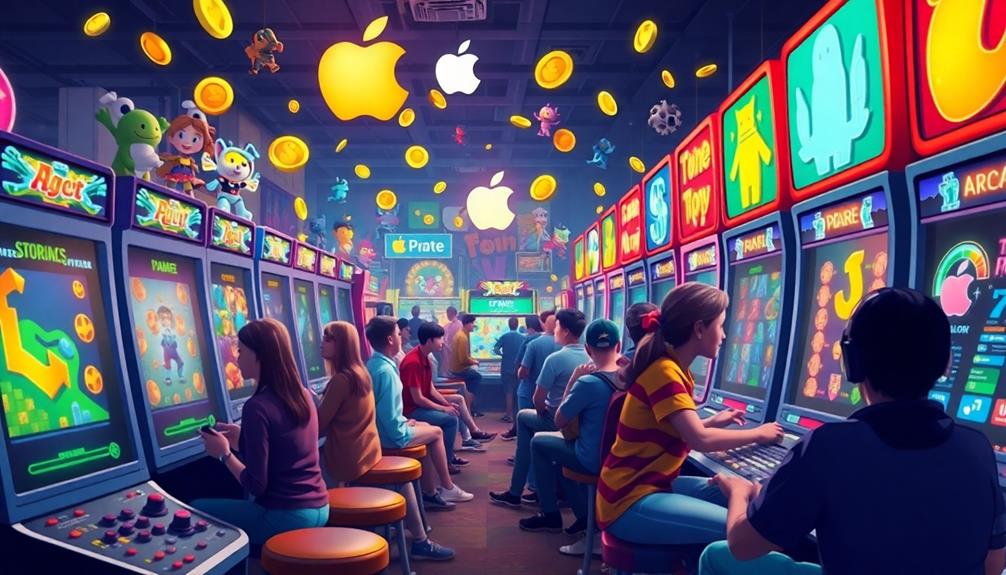Apple Arcade games generate varying levels of revenue, with the popularity of a game playing a significant role. The platform brings in about $210 million per month, but the majority of earnings are captured by top games, accounting for around 30% of the total revenue. Lesser-known titles, especially indie games, often struggle to make significant returns due to this uneven distribution and diminishing upfront payments. The amount developers earn is greatly influenced by user engagement, with decreasing per-play bonuses posing challenges for financial sustainability. If you’re interested in understanding how these factors impact different game types and their developers, there is much more to explore.
Key Takeaways
- Apple Arcade generates approximately $210 million monthly from subscriptions, with top games driving significant revenue.
- The top 10 games account for around 30% of total revenue, limiting earnings for lesser-known titles.
- Indie developers face challenges due to reduced upfront payments and declining per-play bonus pool payments since October 2020.
- Player engagement levels significantly influence revenue shares, affecting overall earnings for individual games.
- Revenue distribution is heavily skewed, making it difficult for many games to achieve meaningful financial returns.
Overview of Apple Arcade Revenue
Apple Arcade generates about $210 million each month from subscriptions, but the revenue distribution isn't as equitable as you might think. While the platform aims to support developers by providing a steady revenue stream, the reality is that a small percentage of premium games dominate the earnings. In fact, a report by Sensor Tower found that just 1% of Apple Arcade games accounted for about 25% of the total revenue. This means that the majority of developers on the platform are not seeing as much financial support as they had hoped for. This lopsided revenue distribution model has drawn comparisons to the pay-to-play model often seen in dave and busters arcade games, where a select few games generate the majority of profits while others struggle to gain traction.
According to recent trends, the ongoing issue of revenue distribution affects not only Apple Arcade but also other platforms where top platforms include freelance sites that offer similar challenges for indie developers. The top 10 games on Apple Arcade can rake in around 30% of the total revenue, leaving many indie titles with minimal returns.
This skewed revenue distribution raises concerns about the sustainability of earnings for developers. Since October 2020, developers have reported a decline in per-play bonus pool payments, which directly impacts their overall revenue from the Arcade.
Additionally, initial upfront payments for new titles have been cut, making it even harder for indie developers and lower-budget games to thrive. As Apple continues to feature a select few popular games, many talented developers may struggle to gain traction and visibility.
The platform's subscription model, while promising, often falls short for those creating innovative indie titles, highlighting the challenges they face in this competitive landscape.
Developer Payment Structures

The challenges surrounding revenue distribution on Apple Arcade directly impact how developers are compensated. Initially, developers enjoyed generous upfront payments and per-play bonus pool payments, but since October 2020, these figures have notably declined. This shift raises concerns about financial viability for many creators, especially in light of the significance of budget management for maintaining a sustainable business.
- Upfront payments for new titles have been cut.
- Per-play bonus pool payments have decreased, causing frustration.
- Revenue distribution heavily favors top 10 games, absorbing about 30% of total revenue.
- Lesser-known titles struggle to earn meaningful returns.
- Developers face uncertainty due to a lack of transparency in metrics and payment structures.
This landscape complicates developer earnings, as many find it challenging to predict their income. The diminishing upfront payments and unclear calculations foster a sense of uncertainty, making it difficult for developers to plan for the future.
As you navigate the Apple Arcade ecosystem, understanding these payment structures is vital. You need clarity on how your game may perform among the top titles to guarantee your financial goals can be achieved. Ultimately, a more transparent approach from Apple could help alleviate developers' concerns and foster a healthier environment for all.
Market Competition Analysis

Maneuvering the competitive landscape of subscription gaming reveals significant challenges for Apple Arcade. As new players like Netflix enter the market, Apple faces pressure to adapt its strategy. Revenue distribution within Apple Arcade is heavily skewed, with a small percentage of popular games reaping most of the financial rewards. This raises developer concerns about declining payouts and the sustainability of their titles.
Here's a snapshot of the current market competition:
| Service | Revenue Concentration | Developer Support |
|---|---|---|
| Apple Arcade | Top 10 games: 30% | Concerns over payouts |
| Netflix Gaming | Growing presence | Inclusive of AAA titles |
| Other Platforms | Diverse revenue streams | Varied development support |
The lack of major AAA games on Apple Arcade limits its game diversity, making it harder to compete effectively. Developers are worried about upfront fees being cut, which could hinder the appeal of creating new games for the platform. If Apple doesn't adjust its approach soon, it risks losing ground in the ever-evolving subscription service market.
Game Popularity and Earnings

Revenue distribution on Apple Arcade reveals a stark reality: a handful of games dominate the earnings landscape. The top 10 games capture approximately 30% of total revenue, while many others struggle to make an impact. This skewed distribution highlights the significance of popularity and player retention in driving earnings.
In today's tech environment, the intersection of gaming and AI Software Engineer Jobs can lead to innovative game development practices that enhance player engagement.
- Engagement levels dictate revenue shares.
- Bonus payments have been declining since October 2020.
- Family-friendly games with established properties thrive.
- Original titles face challenges in sustainability.
- Financially successful games create a vast earnings gap.
For developers, achieving high player retention is vital as it notably influences bonus pool payments. Without consistent engagement, earnings diminish sharply.
The concentration of subscriptions—around $210 million monthly—further exacerbates the issue, leaving many original titles underfunded. The industry's shift towards family-friendly games often sidelines innovative concepts, raising concerns about long-term sustainability.
In this competitive environment, it's clear that only a select few can enjoy substantial financial success. As a developer, you must navigate this landscape carefully, focusing on what makes your game appealing to stay relevant amidst the ever-changing dynamics of Apple Arcade.
Future Prospects for Revenue

Steering the future of revenue in Apple Arcade presents both challenges and opportunities for developers. With around 30 million subscribers in the U.S. and 60 million globally, the potential for revenue is significant. However, the distribution of earnings remains heavily skewed towards a few popular games, which means many indie games may struggle to find their footing.
To navigate this landscape, developers must prioritize high-quality content and user experience, as content relevance and authority are prioritized in holistic SEO.
Developer satisfaction is waning, especially as player retention metrics directly affect bonus pool payments. If engagement levels don't improve, the long-term viability of revenue for these developers could be compromised.
The platform's focus on family-friendly games can limit the appeal and revenue potential for original titles, making it hard to attract diverse audiences.
As the ongoing decline in per-play bonus pool payments and upfront fees continues, you'll need to get creative. Emphasizing player retention and crafting compelling experiences will be essential.
Finding ways to engage subscribers more effectively could lead to better outcomes. Ultimately, balancing the need for popular titles with the inclusion of innovative indie games will shape the future landscape of Apple Arcade's revenue opportunities.
Frequently Asked Questions
Is Apple Arcade Profitable for Apple?
You might wonder if Apple Arcade's profitable for Apple. While it generates significant subscription revenue, challenges like uneven developer payouts and player retention metrics complicate its long-term profitability, making the future uncertain for both Apple and developers. Despite these challenges, Apple Arcade has the potential for growth and success. With the recent addition of the ability to play Apple Arcade games on TV through Apple TV, the service has expanded its reach to a wider audience. Additionally, the promise of exclusive, high-quality games and the integration with other Apple services may entice more subscribers, ultimately boosting its profitability in the long run. However, maintaining long-term success will depend on how well Apple addresses issues like the wifi requirements for Apple Arcade, ensuring smooth gameplay across devices without disruption. As the platform continues to evolve, addressing technical hurdles and offering more flexible payment structures for developers could further enhance its appeal. Ultimately, consistent innovation and attention to user experience will be key to securing Apple Arcade’s place in the highly competitive gaming market.
How Profitable Are Arcade Games?
Arcade games' profitability fluctuates, often failing to fulfill financial forecasts. You'll find indie developers struggling, while top titles thrive. Engaging gameplay is essential, yet many face financial frustration in this competitive, crowded climate.
How Much Do Apple Store Games Make?
You might notice that Apple Store games' earnings have fluctuated recently, with paid titles making a smaller percentage of revenue. Developers often struggle, but subscription models like Apple Arcade offer new opportunities for consistent income.
How Do Apple Arcade Pay Developers?
Apple Arcade pays developers through upfront fees and per-play bonuses, but these payments have decreased. You'll find that revenue distribution favors top games, leaving many indie developers with minimal returns and frustration over payment clarity.
Conclusion
In the world of Apple Arcade, the potential for earnings contrasts sharply with the competitive landscape developers face. While some games soar to popularity, raking in impressive revenue, others struggle to break through the noise. As you ponder the future of Apple Arcade, consider how innovation and player engagement can turn the tide. It's a balancing act—between creativity and commerce—that could redefine the gaming experience, keeping you intrigued about what's next in this ever-evolving market.









